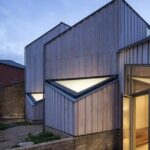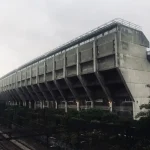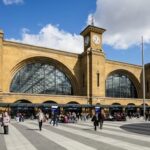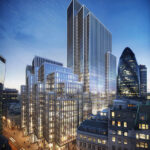Harlequin 1 BSkyB London, UK television production building architect, Sky broadcast design images
Harlequin 1, BSkyB : Broadcasting Building London
London TV production & transmission facility building design by Arup Associates, UK
post updated 18 May 2025
Architect: Arup Associates
A ‘factory for creativity’ that is the most sustainable broadcasting studio yet designed:
The Harlequin 1 building at BSkyB’s West London campus sets an international benchmark for sustainable architecture in a broadcasting environment.
Harlequin 1, BSkyB
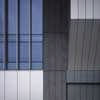

photographs : Christian Richters
9 Aug 2010
Harlequin 1, BSkyB
Harlequin 1 is a television production and transmission facility that will house recording, post-production and transmission facilities for Sky’s Broadcast and Sports News departments. In scale this large building is roughly equivalent to two New York City blocks – approximately 100m long and 50m wide.
The building is divided horizontally into three zones: ‘make’, ‘shape’ and ‘share’. Lower floors contain the giant studios within which television content is made. Middle floors contain the data centers, production facilities and editing suites within which the content is ‘shaped’. And the upper floor contains the transmission platforms from which the television signal is ‘shared’.
The architecture of the building dramatically expresses its world leading sustainable technology. The giant natural ventilation chimneys of the recording studios are revealed on the exterior of Harlequin 1, which some have likened to a new power station architecture for the twenty-first century – a ‘factory for creativity’. Harlequin 1 is, within its genre, the most sustainable broadcasting, studio and data-centre building yet designed.
More than simple energy reduction, Arup Associates’ interest in “whole-life sustainability” focuses on the human experience of a building too. This philosophy has fed directly to creating a highly effective and flexible layout at Harlequin 1 that is very much in keeping with the working culture at BSkyB.
Post-production and technical spaces are positioned centrally, with office space wrapping around the perimeter of the building to allow access to natural daylight and fresh air, and vistas outdoors and across floors. While a building management system optimises the cooling and ventilation of the building, windows can be individually controlled by occupants.
The building atrium allows a visual communication between all levels of the buildings, providing employees with a sense of scale and location, while a cantilevered zone above the entrance contains a series of people-centred spaces, including greenrooms, breakout zones, a cafe, and meetings rooms.
Integrated Sustainable design:
BskyB’s brief for a world leading, genuinely sustainable HQ has challenged Arup Associates both to capture every viable natural resource on the site; and to radically minimize energy use throughout. There are 8 state-of-the-art naturally ventilated studios, naturally ventilated offices for 1370 people, and free-cooled data rooms for more than 400 computer servers.
The collaborative multidisciplinary approach enabled the design of Harlequin 1 to exceed the minimum requirements set out by Part L2A 2006 by 67% and to achieve Energy Performance Certificate (EPC) “A” rating (rating of 22). Bespoke BREEAM 2006 analysis shows that the building achieves “Excellent” rating (score of 72%). During the demolition of the previous building on the site, 97% of the construction waste and 90% of the demolition material was recycled.
The naturally ventilated studios are of particular interest. Studios require very close control of external noise. Natural ventilation would appear to be counter-intuitive, as noise is normally brought in along with the fresh air. Arup Associates have designed a system driven by the waste heat given off by the studio lights. Hot air from the lights would usually need to be cooled mechanically.
In this case the air rises out through giant ventilation chimneys visible on the exterior of the building, drawing in cool, fresh, external air below the studios through a series of sound attenuators. Where external conditions are inappropriate for natural ventilation, mechanical ventilation and cooling of the studio spaces can be implemented.
The project will incorporate on-site renewable energy generation to exceed the Mayor of London’s current expectation. A biomass fuelled Combined Cooling Heating and Power plant will provide sufficient renewable energy to reduce the carbon emissions by more than 20%, enough energy annually to power the equivalent of 3000 homes, and heat 600 homes.
The project aims to offer further renewably generated energy to feed future neighbours on adjacent sites. Two wind turbines will effectively provide enough energy to drive the annual office lighting requirements of the building. Sufficient flexibility has been built into the infrastructure to ensure that future new sustainable technologies such as, for example, hydrogen fuel cells, can be incorporated into the project.
Structural Design:
The client needs the building to be operational for the 2012 Olympics and has an 18 month technical fitout, currently in progress, which has led to a challenging construction programme.
A steel frame was chosen to enable rapid erection of the primary frame, with the design being released ahead of following trades to overcome fabrication lead-in time. One of the significant challenges of incorporating studio facilities into a building is how to span the building above over the large studio spaces.
Our choice of long-span cellular beams, which could span clearly over the studios and provide column-free office space above, avoided the need for costly transfer structures above the studios. The building services can be integrated within the beam depths enabling the floor-to-floor heights to be minimised. This strategy produced a saving of 2m on the overall building height, equivalent to £0.5M off the cladding budget.
The building is also used as a satellite transmission facility, imposing strict sway and rotation limits on the building structure. Steel bracing is provided within the façade to maximise its lever-arm from the centre of mass of the building and hence its efficiency. To minimise the impact on the aesthetic of the façade this bracing is hidden in stair cores and behind the studio chimneys as they rise up the building.
Production facilities of this type are normally massively energy consuming. Arup Associates have integrated a raft of processes and technologies to drastically reduce the energy profile of the building, whilst ensuring that the way the building works is also sustainable from a human perspective. Sky is fully committed to creative, sustainable design. At Harlequin 1, Arup Associates have worked with Sky and the local authority to set an international benchmark for sustainability.
Photographs: Christian Richters
Harlequin 1, BSkyB images / information from AA
Website post about this project: https://www.arup.com/projects/sky-studios/
Location: Hounslow, Northwest London, England, UK
London Buildings
Contemporary London Architecture
London Architecture Designs – chronological list
London Architecture Walking Tours by e-architect
BBC – Broadcasting House
1932
Val Myer

photo © Nick Weall
Broadcasting House
BBC – Broadcasting House redevelopment
2003-
Sir Richard MacCormac [MacCormac Jamieson Prichard Architects]
from early 2006
Sheppard Robson Architects

photo © Adrian Welch
Broadcasting House redevelopment architects : Sheppard Robson Architects
Broadcasting House redevelopment initial architects : MacCormac Jamieson Prichard
BBC Television Building, Queen Street, Edinburgh, Scotland – featured on the Edinburgh Architecture website
Comments / photos for the Harlequin 1, BSkyB Building page welcome

